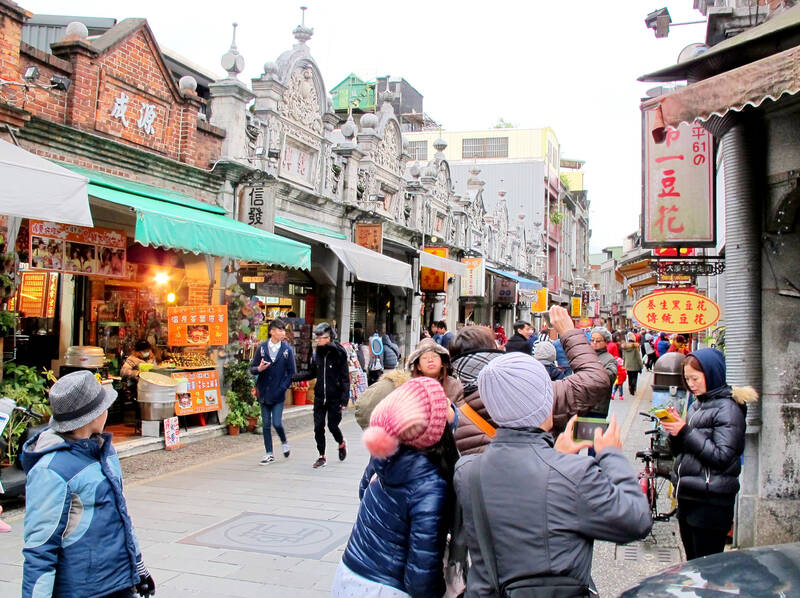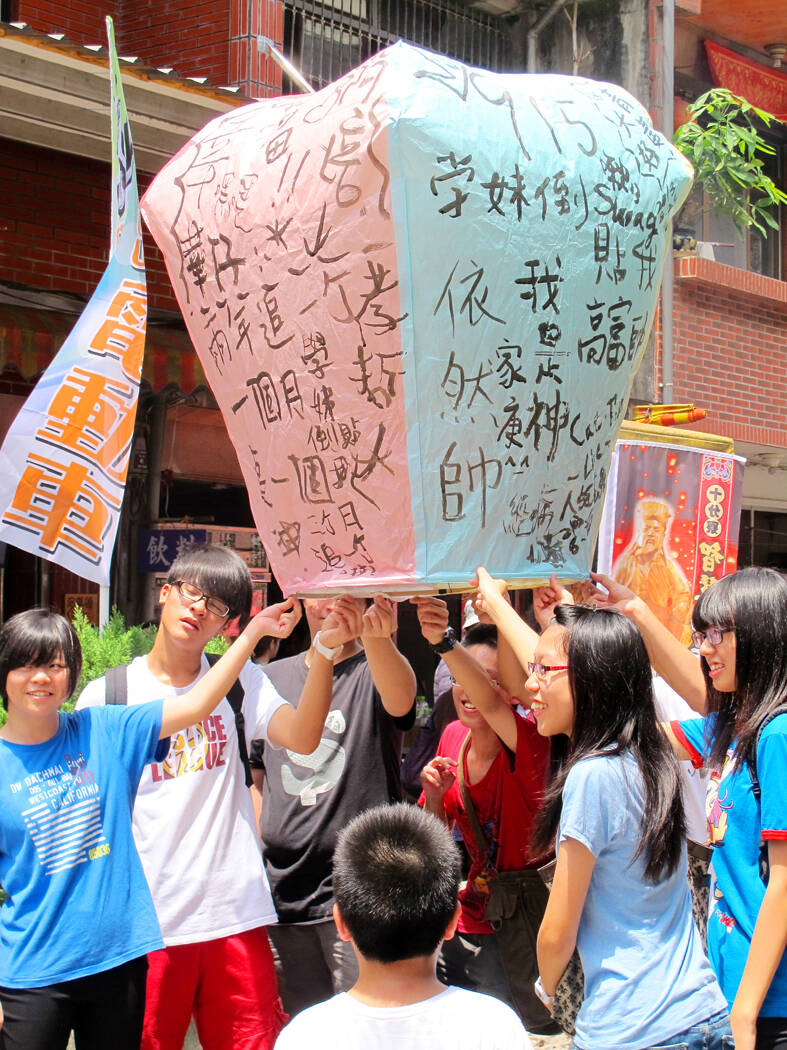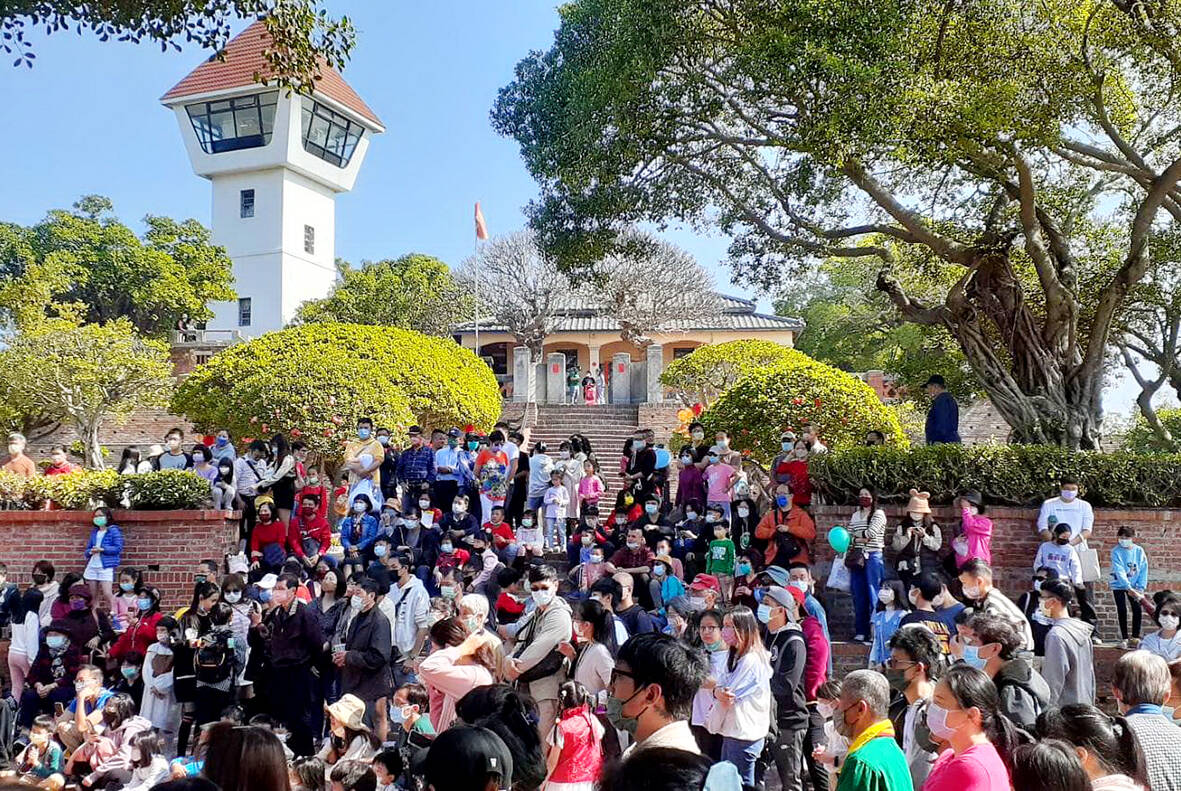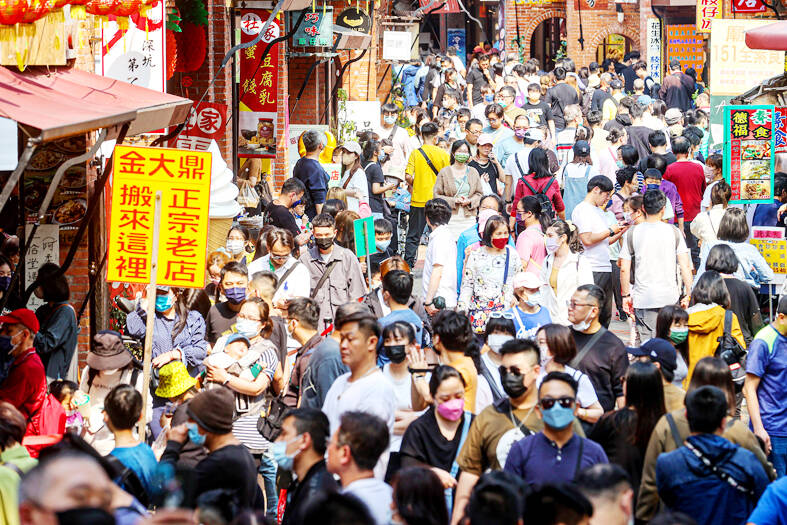Taiwan has never attracted as many visitors as Thailand or Spain, and neither Taipei nor Tainan are nearly as popular as Amsterdam or Paris, yet certain parts of the country already suffer the downsides of mass tourism.
So far, things haven’t got as bad as in Hallstatt, the Austrian lakeside community where up to 10,000 people per day pass through a village with just 700 inhabitants. Or in Barcelona, where demand for tourist accommodation is blamed for real-estate prices that make it almost impossible for young people to establish their own households.
But overtourism already impacts the quality of life for those who reside near attractions like Fort Zeelandia in Tainan’s Anping District (安平), yet don’t benefit from the inpouring of sightseers and their dollars.

Photo: Steven Crook
There are also environmental consequences. On Oct. 19, the Chinese-language United Daily News reported that five intertidal zones on Pingtung County’s Siaoliouciou Island (小琉球) have seen significant declines in marine life “due to the trampling of tourists.”
LACK Of VISION
Raymond Ko (高力文), a Taiwanese-American freediving instructor based in Siaoliouciou, says that when tourists arrive in large numbers, “the traffic gets bad, especially as Taiwanese like to travel in packs. You often see 20-odd scooters following each other.”

Photo: Steven Crook
Some visitors can be loud very early in the morning, to the annoyance of residents. “I get that they’re having a good time,” Ko says, adding that he hasn’t noticed any official effort to get tourists to behave in a more considerate manner.
According to Ko, the most serious overcrowding occurs at Dafu (大福) on the island’s southeastern coast.
“It’s a tiny beach, and there can be a lot of freedivers, a lot of scuba divers and a lot of SUPers [standup paddleboarders],” he says.

Photo: CNA
Ko doesn’t want to see restrictions introduced, but if they’re deemed necessary, he says perhaps there should be a limit on the number of SUPers, because each one takes up more space than a freediver or a scuba diver.
Ko says tourism on Siaoliouciou suffers from a lack of long-term vision and multiple layers of government. In addition to the township and county governments, the island falls under Dapeng Bay National Scenic Area, a division of the Ministry of Transportation and Communications’ Tourism Administration. What’s more, the local fishermen’s association is very influential.
TOUR GROUP MAGNETS

Photo: CNA
Kenting (墾丁) and Sun Moon Lake (日月潭) are the two places in Taiwan which have suffered most from overtourism, says Ian Rowen, an associate professor in the Department of Taiwan Culture, Languages and Literature at National Taiwan Normal University.
Rowen attributes Kenting’s perennial popularity to a lack of alternative beach resorts that have both reliably sunny weather and a good range of amenities. Overtourism became a problem at Sun Moon Lake due to an influx of tour groups and the region having dozens of hotels and resorts with a spectrum of price points, he says.
In both places, “group-tour cartels herded Chinese tourists into resorts where they got good rates in order to channel them into commission-paying shops,” Rowen says. Beijing’s decision to “punish” Taiwan for electing President Tsai Ing-wen (蔡英文) in 2016 by tapering down the number of Chinese allowed to visit relieved the pressure on both destinations, he says.
Rather than take to the streets in protest, or communicate their unhappiness through anti-tourist graffiti, Taiwanese who live near major tourist destinations have tended to grumble in private about traffic, noise and littering.
However, in One China Many Taiwans: The Geopolitics of Cross-Strait Tourism, published by Cornell University Press earlier this year, Rowen speculates that if the 2016 presidential election had been won by someone more to China’s liking, Taiwan might have witnessed more overt expressions of discontent. Misgivings over the direction of cross-Strait relations, compounded by overtourism, might well have led to protestors targeting tourists as “symbolic ambassadors of the Beijing regime,” he says.
TOURIST TAX?
Taiwan looks to be on course to meet the Tourism Administration’s target of six million overseas visitors this year. The authorities are hoping for a record-breaking 12 million international tourists next year. In 2019, the last full year before the pandemic, there were 11.84 million visitors.
Rowen says this number is overambitious, and not just because of the precarity of the global economy. If Taiwan welcomes evermore tourists, “locals will get priced out of hotels and traffic congestion will get worse. Some roads can barely handle the traffic, even in tourist lulls, so spending on infrastructure upgrades will probably be needed,” he says.
Several popular destinations in Europe and the Caribbean impose a per-night tax on every tourist who books accommodation. Next year, Venice will start charging day-trippers aged 14 or older five euros (NT$170) each to enter the canal city.
If similar levies were introduced in Taiwan in an effort to reduce overtourism, Kenting would be an obvious candidate for a tourist tax, as would Sun Moon Lake, Rowen says.
“But I wouldn’t do it this year, while tourism is still recovering from the pandemic, or even next year,” he adds.
There are precedents for such fees. Until 2000, visitors to Sun Moon Lake had to pay an entry fee set by the Nantou County Government. But soon after the creation of Sun Moon Lake National Scenic Area — a division of what was then the Tourism Bureau, now the Tourism Administration — this admission charge was scrapped to encourage tourism and boost the area’s recovery from the 921 Earthquake, according to an Apr. 1, 2014 report in Taiwan Review.
OTHER SOLUTIONS
Asked if there are other ways in which Taiwan can tackle overtourism and the problems that it brings, Rowen says he is in favor of people having more days off. In addition to increasing general well-being, more vacation time would also reduce the bottleneck-effect that jams roads and drives up prices during long weekends and the Lunar New Year period.
Rowen says the Tourism Administration should partner with smaller outfits that are already trying to develop high-value experiential tourism in less-congested areas. This kind of tourism, he explains, can “promote conservation and bring prosperity to more people, compared to the current model of facilitating yet more mass tourism to theme parks and other over-impacted destinations.”
The rules which govern access to beaches, rivers and mountains have impeded the growth of adventure tourism, Rowen says. “Some of these places could be developed into high-value destinations. For example, in the east there are rivers that could be used for whitewater rafting.”
Garrett Ball, a Californian who owns a surfing-oriented hostel and eatery in Yilan County, endorses Rowen’s view that official attitudes to surfing verge on “suppression.”
Rowen says that surfing could be one of the east coast’s major draws if the sport’s enthusiasts were encouraged to develop tourism products. But he laments the frequency with which people have been fined for hitting the waves at locations or on days that the authorities deem to be dangerous.
“We should be working with these people, not arresting them,” he says.
Ko argues that Siaoliouciou’s tourism businesses should “try to move up the value chain and make more money from fewer people.” The best way to do this, he says, would be to focus on a single overseas market.
“People from Hong Kong love Taiwan, and for them it’s so close and so cheap,” he says. So far, however, Siaoliouciou hasn’t featured much in promotional efforts aimed at the special administrative region.
Encouraging digital nomads to spend time on the island would help local tourism escape the feast-or-famine cycle.
“It could happen, if we had a coworking space and affordable and flexible short-term rentals. I’m sure we could attract digital nomads not only from overseas, but during winter also from Taipei, when the weather here is amazing,” Ko says.

Sept. 1 to Sept. 7 In 1899, Kozaburo Hirai became the first documented Japanese to wed a Taiwanese under colonial rule. The soldier was partly motivated by the government’s policy of assimilating the Taiwanese population through intermarriage. While his friends and family disapproved and even mocked him, the marriage endured. By 1930, when his story appeared in Tales of Virtuous Deeds in Taiwan, Hirai had settled in his wife’s rural Changhua hometown, farming the land and integrating into local society. Similarly, Aiko Fujii, who married into the prominent Wufeng Lin Family (霧峰林家) in 1927, quickly learned Hoklo (commonly known as Taiwanese) and

The low voter turnout for the referendum on Aug. 23 shows that many Taiwanese are apathetic about nuclear energy, but there are long-term energy stakes involved that the public needs to grasp Taiwan faces an energy trilemma: soaring AI-driven demand, pressure to cut carbon and reliance on fragile fuel imports. But the nuclear referendum on Aug. 23 showed how little this registered with voters, many of whom neither see the long game nor grasp the stakes. Volunteer referendum worker Vivian Chen (陳薇安) put it bluntly: “I’ve seen many people asking what they’re voting for when they arrive to vote. They cast their vote without even doing any research.” Imagine Taiwanese voters invited to a poker table. The bet looked simple — yes or no — yet most never showed. More than two-thirds of those

In the run-up to the referendum on re-opening Pingtung County’s Ma-anshan Nuclear Power Plant last month, the media inundated us with explainers. A favorite factoid of the international media, endlessly recycled, was that Taiwan has no energy reserves for a blockade, thus necessitating re-opening the nuclear plants. As presented by the Chinese-language CommonWealth Magazine, it runs: “According to the US Department of Commerce International Trade Administration, 97.73 percent of Taiwan’s energy is imported, and estimates are that Taiwan has only 11 days of reserves available in the event of a blockade.” This factoid is not an outright lie — that

Former Chinese Nationalist Party (KMT) chairwoman Hung Hsiu-chu’s (洪秀柱) attendance at the Chinese Communist Party’s (CPP) “Chinese People’s War of Resistance Against Japanese Aggression and the World Anti-Fascist War” parade in Beijing is infuriating, embarrassing and insulting to nearly everyone in Taiwan, and Taiwan’s friends and allies. She is also ripping off bandages and pouring salt into old wounds. In the process she managed to tie both the KMT and the Democratic Progressive Party (DPP) into uncomfortable knots. The KMT continues to honor their heroic fighters, who defended China against the invading Japanese Empire, which inflicted unimaginable horrors on the